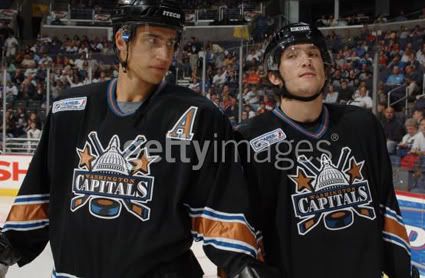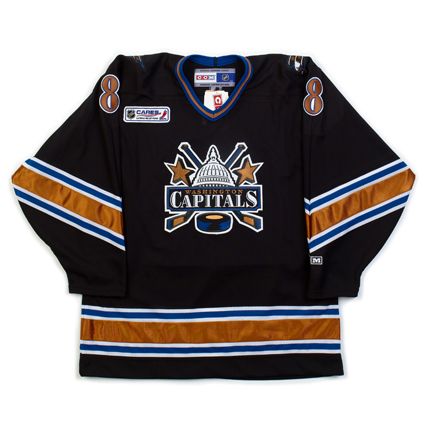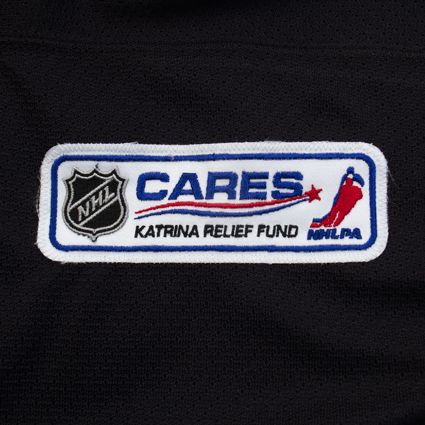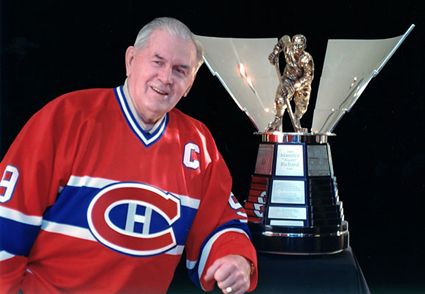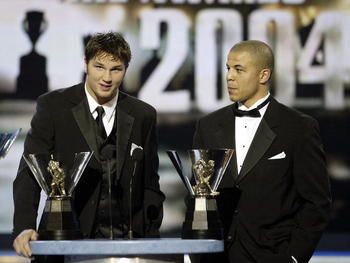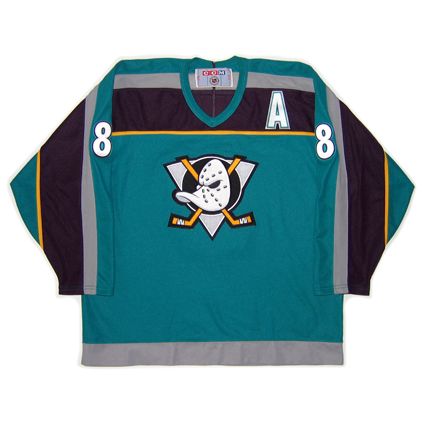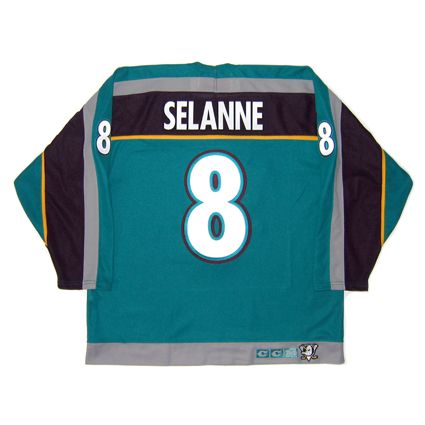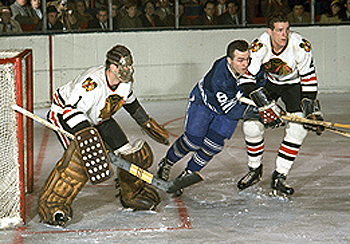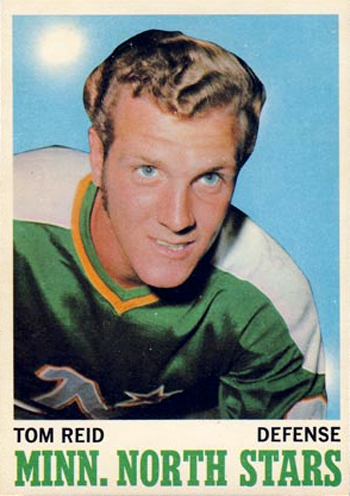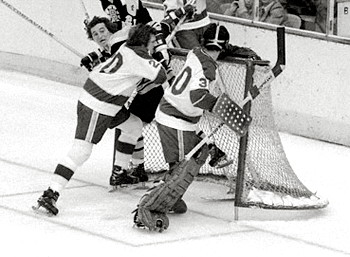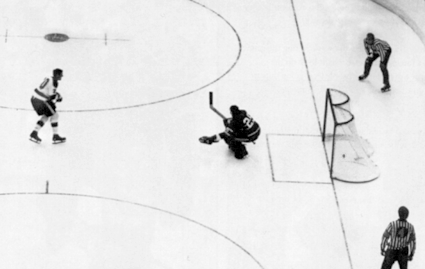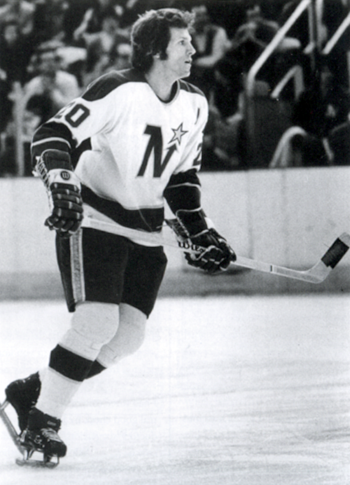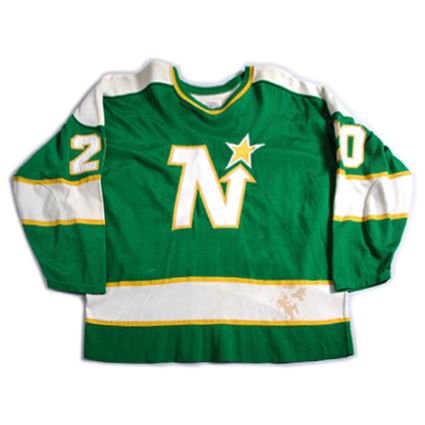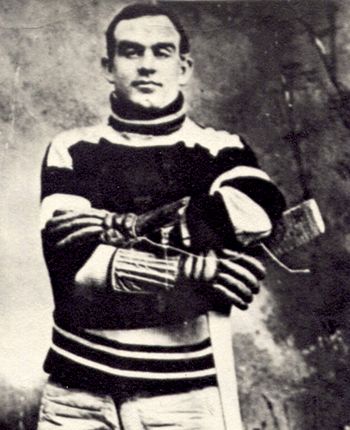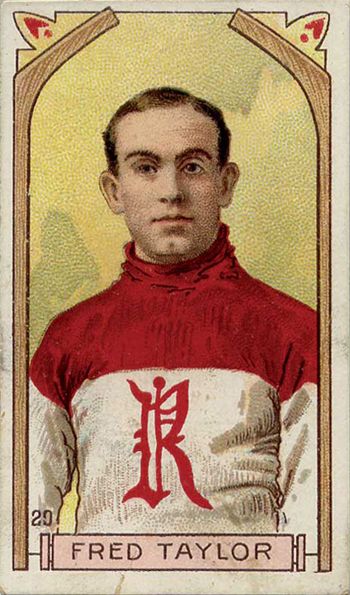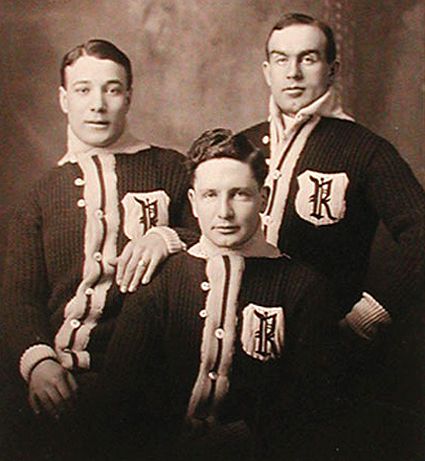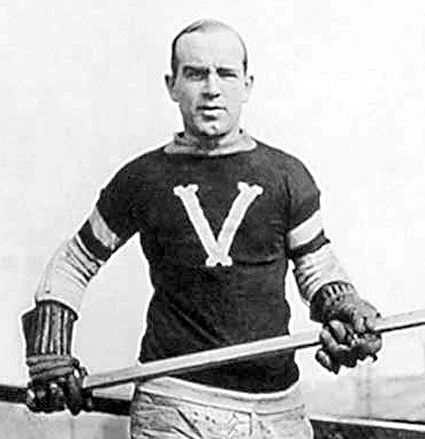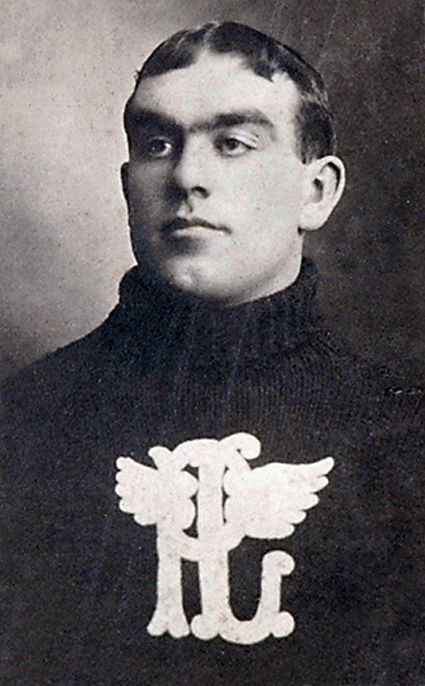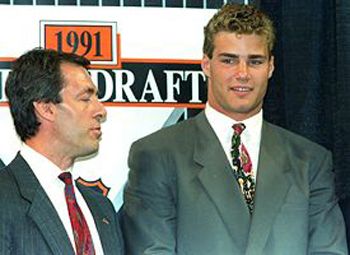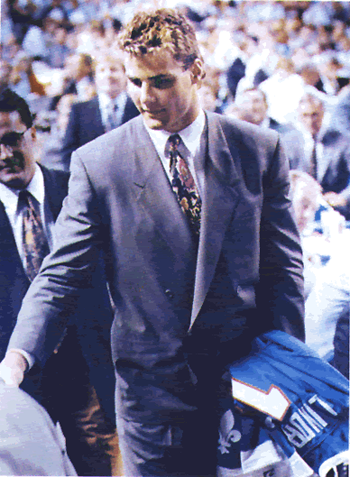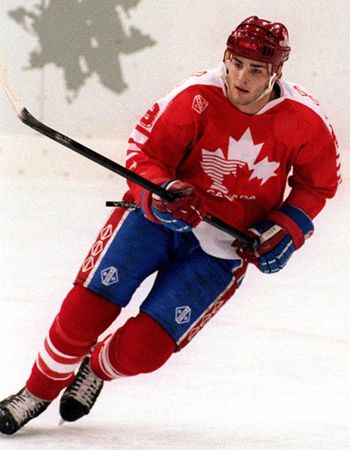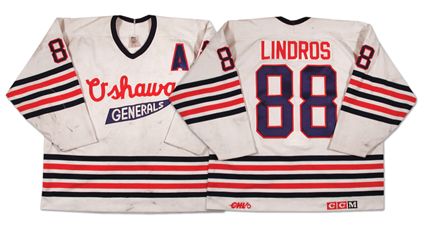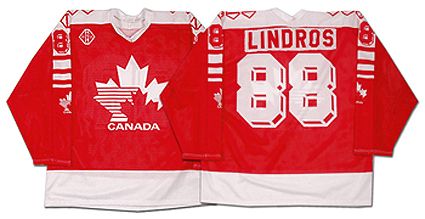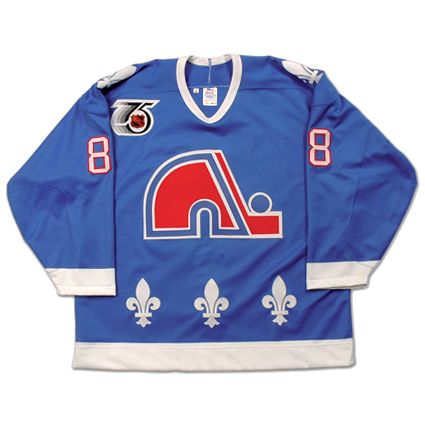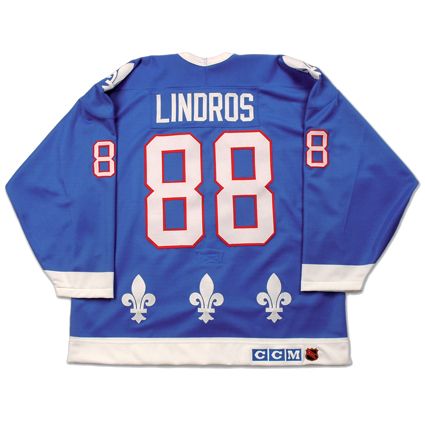Saturday, June 26, 2010
2005-06 Washington Capitals Alexander Ovechkin Jersey
Taylor Hall was drafted #1 overall last night in the 2010 NHL Entry Draft by the Edmonton Oilers. Hall, from the Windsor Spitfires of the OHL will be looking to establish himself as a bona fide NHL player, if not a star in the NHL.
The four players drafted first overall on this date are a mixed bag of success, and include Alexandre Daigle, picked #1 by the Ottawa Senators in 1993, Patrik Stefan, the first ever choice by the Atlanta Thrashers in 1999, Alexander Ovechkin, selected first overall by the Washington Capitals in 2004 and John Tavares, made the overall number one choice by the New York Islanders just last year.
While Daigle managed to play in the NHL for 10 seasons, he never managed more than 51 points in any season, scored a high of only 26 goals, one of only two seasons with 20 or more, was traded four times, including twice in one day, and found himself out of hockey after only seven seasons and four different teams at the age of 25. He made a comeback after two seasons away from the game and made his way back to the NHL with the Pittsburgh Penguins for half a season. He then signed with the Minnesota Wild for a season and a half, which it must be noted included his second 20 goal season and equalling his career high of 51 points.
After leaving the NHL, Daigle has continued to play professionally in Switzerland, putting up as many as 61 points in a 44 game season. Overall however, Daigle is considered to be a draft bust considering his lofty status as the #1 pick and having never scored more than 51 points in an NHL season, when compared to the 137 he scored in 53 games in junior hockey in 1992-93.
Stefan, a center from the Czech Republic, the first overall choice by the Thrashers failed to impress during six seasons with Atlanta. Stefan's playmaking abilities did not make up for his goal totals, which hovered between 5 and 14. Never registering more than 26 assists, Atlanta shipped him out to the Dallas Stars, where he played only 41 games, which included one of the biggest gaffes in NHL history, when he failed to put the puck into an empty Edmonton Oilers net from inside the Oilers crease! To make matters worse, the Oilers got control of the puck and scored with 2 seconds remaining to send the game into overtime, earning him heaps of ridicule from announcers and fans alike.
(note the Oilers wearing the Teammates for Kids patch on their jerseys in the video, worn only on January 4, 2007)
At the conclusion of the season, Dallas chose not to resign him and he too moved to Europe but played only 3 games for SC Bern in Switzerland before retiring from hockey. Stefan is clearly considered a bust and his failure to develop clearly hurt the Thrashers, who have only qualified for the playoffs once in their ten years, a first round sweep by the New York Rangers in 2007, the year after Stefan was dealt to Dallas.
Ovechkin, taken first overall in 2004 really needs no introduction. Currently the most dynamic player in the world today, Ovechkin has already scored more NHL points in five seasons than Daigle and Stefan combined, including 52 goals as a rookie, leading the league in scoring in 2008 and leading the league in goals in 2008 and 2009. His hardware cabinet includes the Calder Trophy, the Pearson Award/Lindsay Award three times, the Art Ross once, the Hart Trophy twice and the Richard Trophy twice. Internationally, Ovechkin has won a gold, silver and two bronze medals at the World Championships after capturing a gold and a silver at the World Juniors.
Additionally, he hits like a freight train, is currently a +64 for his career and celebrates each goal with the joy of a kid. The Oilers can only hope to get a player of his quality and caliber.
Tavares was selected first overall just one year ago wasted little time letting the league know he had arrived, scoring a goal and an assist in his first ever game on October 3, 2009. He ended up finishing second in rookie scoring with 54 points while playing in all 82 games.
Internationally, he's off to a good start, having won gold medals at the 2008 and 2009 World Juniors, including being named the MVP in 2009 after scoring 15 points in six games, and was named, at just 19 years of age, to Team Canada for the 2010 World Championships.
Will Tavares increase his scoring totals as he becomes accustomed to the NHL game and continues to mature, or will he follow the path of Daigle (who scored 51 points in his rookie season) and become a pedestrian player who failed to live up to the lofty expectations of a number one draft pick?
The Islanders, just like the Oilers now, will be hoping their scouting, research and judgement will pay off with an ace, rather than a joker.
Today's featured jersey is a 2005-06 Washington Capitals Alexander Ovechkin jersey as worn during the first period of Ovechkin's first ever NHL game with the NHL Cares/Katrina patch on the right chest.
The NHL Cares/Katrina patch was worn by all players during just the first period of their first home game of the 2005-06 season. The game worn jerseys were then auctioned off for charity to raise funds for the Hurricane Katrina Relief Fund. Ovechkin's jersey sold for a high bid of $6,710.
Here is Daigle being taken first overall by the Senators in 1993, a pick that was "the consensus number one draft pick, the best player available".
Next up is Patrik Stefan being selected first in 1999, the first ever pick by the Atlanta Thrashers in their history. "A player you can build your franchise around. No doubt about it." Oops.
Here is Alexander Ovechkin being taken #1 overall by the Capitals in 2004. Nice Sunday school hair, Alex.
We follow with a profile of John Tavares, last year's #1 overall draft pick.
Finally, we conclude with Taylor Hall being selected #1 in the 2010 NHL Entry Draft by the Edmonton Oilers.
Labels:
Ovechkin Alexander,
Washington Capitals
Friday, June 25, 2010
1998-99 Mighty Ducks of Anaheim Teemu Selanne Jersey
On this date in 1998, the NHL Board of Governors announced the creation of the Maurice "Rocket" Richard Trophy to be awarded to the NHL's leading goal scorer every season.
While Richard never won the Art Ross Trophy as the leading point scorer during his career, he did lead the league in goal scoring on five occasions, was the first player in NHL history to score 500 goals and captured the attention of the hockey world when he became the first player to ever score 50 goals in 50 games.
Maurice Richard with the trophy named in his honor
The trophy, donated by his former club the Montreal Canadiens, was first awarded to Teemu Selanne of the Mighty Ducks of Anaheim, whose 47 goals were three more than his closest pursuers. 1998-99 would actually be the third time Selanne would lead the league in goal scoring, having scored an amazing 76 goals as a rookie in 1992-93 and topped the league the year before with 52. Selanne had also previously won the Calder Trophy as Rookie of the Year following his record-shattering rookie campaign and later added the Masterton Trophy in 2006.
Pavel Bure, then of the Florida Panthers, took home the award the following two seasons with first a dominating 58 goals, 14 more than anyone else, in 1999-2000 and retained the award with 59 goals the following season.
The Calgary Flames Jarome Iginla won his first Richard Trophy after scoring 52 goals to win the goal scoring title by 11. He was followed by the Colorado Avlanche's Milan Hejduk's 50 goals in 2002-03.
The league-wide emphasis on defensive play, the tolerance of obstruction combined with the increasing size of goaltender equipment reached it's peak in 2003-04 when the league leaders in goals were limited to 41 goals, the lowest winning total in the 12 year history of the award.
Three players shared the award that season, Iginla for the second time, Russian Ilya Kovalchuk of the Atlanta Thrashers as well as the 19 year old Rick Nash of the Columbus Blue Jackets.
Rick Nash and Jarome Iginla accept their award in 2004
Following the NHL lockout of 2004-05, rule changes were instituted to eliminate obstruction and limit the size of goalie gear and the resulting increase in goal scoring was immediate, with Jonathan Cheechoo of the San Jose Sharks benefitting from not only the new rules package, but the mid-season acquisition of playmaker Joe Thornton from the Boston Bruins, won the award with 56 goals, double his total of 28 in 2003-04.
Vincent Lecavalier of the Tampa Bay Lightning set a career high with 52 goals on his way to the goal scoring title in 2006-07 the year prior to the third Russian to win the award, the dynamic Alexander Ovechkin of the Washington Capitals, who won back to back titles, first with 65 goals in 2007-08, the highest total since the inception of the Richard Trophy, and backed that up with 56 in 2008-09.
Most recently, the Pittsburgh Penguins captain Sidney Crosby broke through with his first title with 51, which he shared with the impressive second year player Steve Stamkos of the Lightning, who equalled Crosby's goal total of 51.
Today's featured jersey is a 1998-99 Mighty Ducks of Anahiem Teemu Selanne fourth jersey, as worn during the season Selanne's 47 goals won the inaugural Richard Trophy.
Third, or "alternate", jerseys were first introduced to the NHL in 1995-96, with the Mighty Ducks first alternate jersey being the disastrous "Wild Wing" jersey, abandoned after only six wearings. The Mighty Ducks reentered the alternate jersey program in 1997-98 with a white jersey (first worn during one of their opening pair of games in Japan) and for good measure produced today's featured jersey, a jade version of the white jersey. It was the first time in NHL history that a team had a fourth different jersey to pick from.
This jade fourth jersey was worn for just two seasons before being retired. Selanne was the NHL's leading goal scorer both of the two seasons this jersey was used, including winning the inaugural Rocket Richard Trophy in 1999.
Our next video is Alexander Ovechkin accepting his Richard Trophy in 2009.
Here is an interview with 2010 Richard Trophy winners Stamkos and Crosby.
Labels:
Mighty Ducks of Anaheim,
Selanne Teemu
Thursday, June 24, 2010
1973-74 Minnesota North Stars Tom Reid Jersey
Born on this date in 1946, Tom Reid had a 12 year NHL career that started with the Chicago Black Hawks.
Tom Reid with the Black Hawks
Reid, a defenseman played for the St. Catharines Black Hawks of the Ontario Hockey Association from 1964-65 to 1966-67. A defensive defenseman, Reid is described in his biography on the Hockey Hall of Fame's Legends of Hockey website as "a stay-at-home defender who viewed the offensive zone as a distant moon"!
He graduated from junior hockey just as the NHL expanded from six teams to 12 and landed a spot on the Chicago blueline with 56 games in his rookie season of 1967-68 as well as seeing his first taste of playoff action with nine postseason games. After 30 games with Chicago in 1968-69, he was traded to the Minnesota North Stars on Valentine's Day in 1968. In all, he played 86 games for the Black Hawks, totaling seven assists.
Reid competed in the final 18 games of the North Stars schedule and established himself as a regular the following season with 66 games played, which included his first NHL goal.
The 1970-71 season saw his offensive output leap up to 17 points, more than double his previous high of eight. Additionally, the North Stars would make a push in the playoffs, first defeating the St. Louis Blues in six games before stretching out the eventual champion Montreal Canadiens to six games for the right to play in the finals. The North Stars 6-3 Game 2 win in Montreal on April, 22 was the first time a 1967 expansion team had ever defeated an Original 6 club in the playoffs.
Tom Reid's 1970-71 rookie card
The 1971-72 season was the most remarkable of Reid's career. It saw the player once described as "a sort of third goal post, firmly anchored to his own zone" go on a goal scoring binge, as he netted six for a career high, including by far the most memorable goal of his career.
Reid doing his best imitation of a third goal post
On October 14, 1971 Tom Reid scored on a penalty shot against Hall of Famer Ken Dryden of the Canadiens. It was scored by the most unlikely of sources, a man who only scored 17 goals in his entire career and the only penalty shot ever scored against Dryden!
As told by long time North Stars announcer Al Shaver in "Minnesota North Stars: History and Memories with Lou Nanne "
"
Let's not forget the shot that was heard around the world. Well, maybe just the hockey world. Allan Thomas Reid was not a prolific scorer among NHL defensemen. In a span of 10 shin-bruising seasons with the North Stars, Tall Tommy scored only 17 goals, but on the night of October 14, 1971, he performed a feat that put him in a class by himself and earned him a place in the team history book. On one of his rare good scoring opportunities, Reid was fouled by a Montreal player and the referee awarded him a penalty shot.Coach Jack Gordon, showing supreme confidence in Reid's scoring prowess, asked the ref, "Does Reid have to take the shot?" To young Thomas that was the ultimate insult, but take the shot he did. Unleashing all of his anger over the coach's lack of confidence, Reid launched a blistering rocket that left Ken Dryden trembling in his skates. The twine behind Dryden bulged, the red light flashed, bells chimed, fireworks filled the air, brass bands started playing, an thousands of fans began chanting, "Tommy! Tommy! Tommy!" And so, a hero was born on that autumn evening, many years ago.
Reid's own version of the event naturally differs slightly from Shavers.
I came out of the penalty box and was heading toward the bench when a clearing pass hit my skate and careened toward the Montreal zone. Instead of going to the bench I went after the puck and had a clear breakaway. Guy Lapointe tripped me from behind and I slid hard into the boards.Referee Bruce Hood skated over and asked if I was okay. I said "Yes," and then, "You're giving him a penalty, right?" He said, "You're getting a penalty shot." I said: "Bruce, go to hell. I don't want a penalty shot." "You got one," he replied.When I got to the bench, coach Jack Gordon asked what was going on. Hood skated over and said, "Let's go." Jack said, "What do you mean?" and was then informed of the penalty shot. Jack said, "Does he have to take the shot?" and I informed Hood that I thought my leg was broken. Hood said, "Let's go or you'll get a delay of game."Everyone on the bench was giving me advice about what to do with the shot, but J. P. Parise simply said, "Put the damn thing behind him."I was so focused as I got ready to take the puck that I couldn't hear a thing. There were 15,000 people in the building, but I heard nothing. It was a warm October night so the ice was a bit wet, and I was worried about carrying the puck across the blue line. My main concern was just getting off a shot.I skated in, got to the high slot, and shot the puck. Ken Dryden wasn't expecting a shot that quickly and he overreacted. I was aiming for the corner, but the puck went between his legs and into the net, my big claim to fame.When I got back to the bench, I said to Jack, "Was there ever any doubt?"
Tom Reid's famous penalty shot goal against Ken Dryden
Reid's 21 points for the season also raised his career best in that category as well. Additionally, his 107 penalty minutes established a career high. In the postseason, Reid scored the only playoff goal of his career against the Blues to cap off a most memorable season.
Two seasons later, Reid set a career hight with 23 points from four goals and a career best 19 assists in 76 games. He stayed true to his defensive roots the following season, again topping 70 games for the fourth time in five seasons with 74 games played, but managed just six points while leaving the point gathering to teammates Dennis Hextall (74 points) and Bill Goldsworthy (72). He did top 100 penalty minutes for only the second and final time in his career with 103.
Reid competed in 69 games in 1975-76, contributing 15 assists and 54 games in 1976-77, adding another eight assists to his career total.
It was around this time that Reid developed a small red rash on his arm, which itched terribly as his skin began to deteriorate. Eventually the condition was given the name "gunk". Eventually league doctors, trainers and equipment manufacturers began to investigate and discovered that about 100 players across the NHL were suffering from various degrees of the same condition, but none as severe as Reid's, whose skin eventually got so bad that he could only sleep sitting upright in a wooden chair.
The condition was so severe, Reid was forced to retire after managing to play only 36 games of the 1977-78 season, in which he scored his final NHL goal and added six assists to push his career totals to 690 games played, 17 goals and 113 assists for 130 points as well as 42 playoff games with one goal and 13 assists. Doctors finally concluded that Reid's rash was caused by allergies to his hockey equipment and the dye in his jersey.
Tom Reid was a terrific defensive defenseman. He was very consisent - game in and game out you knew you going to get strong defense from Tommy. His play never varied.I had three concussions in my career. The third one was the result of a real good check by Dennis Owchar one night in Pittsburgh. At the doctor's suggestion, I had started wearing a helmet after my second concussion to help prevent further ones.But this night in Pittsburgh I was playing defense with Tom Reid, and I was carrying the puck up the ice. I thought I had made a real good move to get by Owchar, but as I slipped the puck though his legs to try to go around him, he hit me with a shoulder right between my shoulder blades and I went down very hard. I hit my head on the ice so hard I eventually had seven stitches, even with the helmet.I tired to get up, was real dizzy and started going back down again. The next thing I know, the trainer, Doc Rose, is on the ice telling me to lie down, that they're going to carry me off.I said, "There's no way. I've never been carried off the ice, and I'm not going to let anybody carry me off now."I tried to get up again, and I went right back down. And as I'm going down this time, Tom Reid leans over and says. "Louie, Louie, before you go, can I have your condominium in Florida?"
Since his retirement from hockey, armed with that same sense of humor, he has worked as a color analyst for the North Stars, Minnesota Gophers and now the Minnesota Wild. He is also the president of the North Stars Almuni Chapter and owner of Tom Reid's Hockey City Pub, the place to meet before and after Wild home games down the street at the Xcel Energy Center and site of the annual Hockey Collectors Expo, next scheduled for Sunday October 3rd from 11 AM to 6 PM, where local collectors share their game worn jersey collections.
Today's featured jersey is a 1973-74 Minnesota North Stars Tom Reid jersey. This was the third style of green jersey worn by the North Stars, with the original having a lace up collar, which was dropped during their first season for a v-neck collar. Starting in season two in 1968-69, a white shoulder yoke was added to the jerseys. This third style remained in use through the 1974-75 season.
Our video section today begins with a look at the 1975-76 Minnesota North Stars, some of the crappiest, most annoying filmmaking in the history of sports. If you choose to suffer though Part 1, I recommend skipping ahead to the 3:58 mark. Perhaps Parts 2 through 5 improve after getting past the first half of Part 1. You click the link, you take your chances...
Labels:
Minnesota North Stars,
Reid Tom
Wednesday, June 23, 2010
1905-06 Portage Lake Hockey Club Cyclone Taylor Jersey
Born on this date in 1884, Fred "Cyclone" Taylor was one of the first stars of the fledgling sport of hockey and one of the leading scorers of his day.
As was common in the early days of organized hockey, Taylor played for several teams in several leagues - depending on where the money was. He joined his is first professional club, thanks to a $3,000 salary offer, the Portage Lakes Hockey Club in Houghton, Michigan in the International Professional Hockey League. Taylor arrived in the latter part of the 1905-06 season in time to score 11 goals in 6 games and help the club win the league championship with a 19-5 record.
He returned for the 1906-07 season and scored 14 times in 23 games as Portage Lakes again won the championship, this time with a record of 16-8. With professional teams now starting up in Canada, many of the players preferred to play closer to home and the IPHL disbanded after before the start of the next season.
Taylor moved back east, joining the Ottawa Senators of the Eastern Canada Amateur Hockey Association for the 1907-08 season. In 1908, Taylor played the start of the season with Pittsburgh of the Western Pennsylvania Hockey League but returned to Ottawa in time for the start of the Senators next season. Once back, he scored 9 goals in 11 games as Ottawa won the league title with a 10-2 record. As champions of the league, Ottawa became the holders of the Stanley Cup, previously held by league members the Montreal Wanderers.
Taylor of the Ottawa Senators
It was during this period that Canada's Governor General was so impressed with his incredible speed that he gave Taylor the nickname "Cyclone".
After a falling out with management of Ottawa, Taylor accepted an offer to join the Renfrew Creamery Kings for the inaugural season of the National Hockey Association.
There he was joined by future hall of famers Lester Patrick, his brother Frank Patrick as well as mid-season addition Newsy Lalonde. The paychecks handed out to the Renfew players earned the club the unofficial nickname of the Renfrew "Millionaires". Taylor's salary in particular was the highest ever for a Canadian athlete up to that time and remained so for many years.
Newsy Lalonde, Frank Patrick and Cyclone Taylor of Renfrew
Despite their high priced talent, Renfrew finished third in the league and reportedly lost $17,000 that season. Taylor returned for the 1910-11 season, only without the Patricks or Lalonde.
The club once again finished third in the standings and disbanded following the season, putting Taylor back on the open market. Sort of.
His rights were transferred to the Montreal Wanderers, but Taylor was quoted as saying he'd rather retire than join the Wanderers and ended up playing in a game for the Ottawa Senators. The Wanderers protested Taylor's appearance for Ottawa and won. The game was ordered replayed, Taylor and Ottawa were fined $100 each and Taylor was given an indefinite suspension, ending his 1911-12 season at one game.
In November of 1912, Taylor was lured to the Vancouver Millionaires by his former teammates the Patrick brothers, who had formed the Pacific Coast Hockey League.
Taylor with the Vancouver Millionaires in 1912-13
There, he would find a permanent home, playing the next nine seasons of his career, which included five scoring titles, thanks in part to moving up to forward from defense, a career high of 32 goals in 18 games in 1917-18 and a Stanley Cup championship in 1915 thanks to a 3 games to none win over Taylor's former club, the Ottawa Senators which included Taylor scoring six times in the three games including twice in the cup clinching Game 3. The victory by the Millionaires remains the only Stanley Cup ever won by a team from Vancouver 95 years later.
1915 Stanley Cup champion Vancouver Millionaires
The Millionaires returned to the Stanley Cup Finals in 1918, and while they fell in seven games to the Toronto Arenas, Taylor led all playoff scorers with 9 goals in 7 games.
He stopped playing hockey after the 1920-21 season, but did return for a single game in the 1922-23 season with the club now renamed the Vancouver Maroons. He finished his career averaging more than a goal per game with 194 goals in 186 regular season games.
Following his playing career, he was elected to the Hockey Hall of Fame in 1947. His son Fred Jr. opened a chain of hockey equipment stores called Cyclone Taylor Sports in 1957 which remain in operation today. Since 1967 the playoff champions of the three British Columbia Junior B hockey leagues is awarded the Cyclone Taylor Cup.
In 1979, the Canucks renamed the club's annual MVP award the Cyclone Taylor Award. There are also arenas in Vancouver and his birthplace of Tara, Ontario named in his honor as well as Cyclone Taylor Boulevard, which is one of the four roads around the current Ottawa Senators arena, Scotia Bank Place in Ottawa.
Today's featured jersey is a 1905-06 Portage Lake Hockey Club Fred "Cyclone" Taylor jersey. Or in this case we should we say "sweater". This classic turn of the century hockey sweater features a wonderful "PL" monogram adorned with wings on either side. This heavy sweater certainly would have kept the players warm, as the IPHL played it's games in the winter on natural ice.
While the Portage Lake team only existed for a limited number years, playing exhibition games as early as 1900 and joining the IPHL in 1904 when they began to attract players of note from Canada with the salaries they were paying in the days of amateur hockey, the lineup of future hall of famers was quite impressive, including IPHL founder Jack Gibson in the Builders category, "Bad" Joe Hall, goaltender Riley Hern, team captain Bruce Stuart, his brother Hod Stuart and of course the legendary Cyclone Taylor.
Today's video is a look at the British Columbia Sports Hall of Fame, of which Cyclone Taylor is a member.
Labels:
Portage Lake Hockey Club,
Taylor Cyclone
Tuesday, June 22, 2010
1990-91 Oshawa Generals Eric Lindros Jersey
Despite his steadfast and repeated warnings he would not play for them, the Quebec Nordiques drafted Eric Lindros with the first overall pick in the NHL Entry Draft on this day in 1991.
The Nordiques Pierre Page with Lindros at the 1991 NHL Draft
Lindros, perhaps the most hyped and anticipated player since Wayne Gretzky or perhaps even Bobby Orr, had already led the Oshawa Generals of the OHL to the 1990 Memorial Cup championship with 45 points in 21 playoff games, scored 149 points in 57 games for the Generals to lead the league in scoring in 1991 and was named the league MVP and the CHL Player of the Year.
Lindros with the Oshawa Generals
While Lindros was tearing up Canadian junior hockey, the Quebec Nordiques were the doormats of the NHL, having finished last overall in 1988-89 with 61 points, suffered through a dreadful 1989-90 season scoring a mere 31 points and "improved" to 46 points in 1990-91, earning the right to select first overall for the third consecutive year.
Having already refused to report to the Sault Ste. Marie Greyhounds in junior hockey, Lindros again made his wishes known that he had no intention of playing for the Nordiques due to several factors which did not meet his or his agent's satisfaction, including limited marketing potential, high tax rates in Quebec and the difficulties associated with the exclusively French speaking Quebec City.
With both sides at a standoff, the stubborn Nordiques selected him with the first overall pick anyway. The even more stubborn Lindros wasted no time in snubbing the Nordiques by refusing to wear the club's jersey for photos.
Lindros refusing to wear a Nordiques jersey at the draft
Undaunted, the Nordiques president Marcel Aubut announced that they would build the team around Lindros and refused to trade him, claiming he would not have a career in the NHL as long as he held out. Meanwhile, Lindros played for Team Canada in the 1991 Canada Cup, briefly returned to the Generals for 13 games prior to joining the Canadian National Team for 24 games, participating in the 1992 World Junior Tournament and then the 1992 Winter Olympics, so there was no shortage of places for him to play during his unprecedented standoff with the Nordiques despite their 10-year, $50 million contract offer.
Lindros skating for Canada during his year long holdout
Eventually, after his year long holdout, the Nordiques relented and traded Lindros at the draft in 1992. The problem was, they agreed to trade him on June 20, 1992 to both the New York Rangers and the Philadelphia Flyers in separate deals!
Eventually the NHL arbitrator would rule in favor of the Flyers on June 30th and with that, it was the Flyers who sent a King's Ransom to the Nordiques in the form of Peter Forsberg, Mike Ricci, Ron Hextall, Steve Duchesne, Chris Simon, Kerry Huffman, two first-round draft choices (one of which was used to select Jocelyn Thibault while the other was traded away) plus $15 million!
The trade would send the franchise on the road to the Stanley Cup, which they would win in 1996 as the Colorado Avalanche, their first season after their relocation to Denver, Colorado.
Today's featured jersey is a CCM 1990-91 Oshawa Generals Eric Lindros jersey as worn the season in which Lindros scored 149 points in 57 games just prior to his being drafted first overall by the Quebec Nordiques.
Bonus Jerseys: Today's first bonus jersey is a Tackla 1991-92 Canada National Team Eric Lindros jersey as used in the 1992 Olympics in Albertville, France while Lindros was refusing to play for the Nordiques in Quebec.
This jersey has all the graphics dye-sublimated onto the jersey and features the unusual white nameplate with red letters on a red jersey.
Today's second bonus jersey is a CCM 1991-92 Quebec Nordiques team issued Eric Lindros jersey made for Lindros to wear in his planned rookie season of 1991-92 with the Nordiques, which went unworn as Lindros made good on his threats to not play for the Nordiques and instead embark on a schedule of games with primarily the Canadian National Team until the Nordiques traded him to the Philadelphia Flyers in time for the 1992-93 season.
Today's first video is the Nordiques following through on their promise to take Lindros first overall in the 1991 NHL Entry Draft.
Here is a report on Lindros refusing to play for the Nordiques prior to the draft.
Labels:
Canada,
Lindros Eric,
Oshawa Generals,
Quebec Nordiques
Subscribe to:
Comments (Atom)

